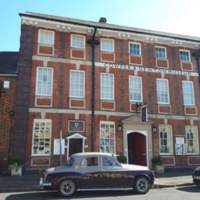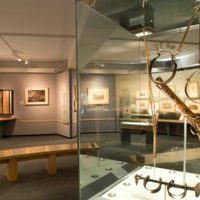
Cowper & Newton Museum
The Cowper & Newton Museum is a very small, local museum managed by a charitable trust and staffed predominantly by volunteers. The museum is situated in Orchard House, the home of poet and author William Cowper between 1768 to 1786. Since it opened in 1900, the museum has focussed on telling the story of Cowper’s life in the thriving Georgian market town of Olney, Buckinghamshire. The museum also examines Cowper's relationship with his friend and neighbour, slave-trader turned ordained priest and abolitionist, Reverend John Newton.
The museum’s mission is for visitors to ‘relive Georgian life in Olney.’ Using items of personal collections relating to both of the museum’s namesakes, the displays bring the house to life in the form of period room settings combined with display cases and interpretive panels. Both Cowper and Newton published writings against the slave trade and corresponded with other abolitionists, including William Wilberforce. The displays provide some context on the slave trade before outlining Cowper and Newton’s involvement in abolition. This is represented through a range of objects including archive material, portraits and furniture both from the museum’s collection, and loaned pieces from Wilberforce House Museum, Hull.
As well as being a theme which runs throughout the whole museum, with Cowper’s ‘The Negro’s Complaint’ on display in the Georgian History Room for instance, there is one particular room on the first floor of the house which focuses predominantly on the slave trade and abolition. Like most of the museums analysed here, the interpretive panels in this display were created using funds made available for the bicentenary in 2007.

National Maritime Museum
The National Maritime Museum is the largest maritime museum in the world. It forms part of the Royal Museums Greenwich UNESCO World Heritage Site. The NMM houses ten galleries that all showcase Britain’s Maritime History. Its mission is 'to enrich people’s understanding of the sea, the exploration of space, and Britain's role in world history’. ‘The Atlantic Worlds Gallery,' launched in 2007 for the commemoration of the bicentenary, charts the interconnections between Britain, Africa and the Americas between 1600 and 1850. The gallery is about the movement of people, goods and ideas across and around the Atlantic Ocean from the 17th century to the 19th century. The connections created by these movements affected people across three continents, impacting on their cultures and communities and shaping the world we live in today. Four main themes are explored within the gallery, including exploration, war, enslavement and resistance. These displays benefited extensively from the museum's purchase of the Michael Graham-Stewart Slavery Collection in 2002. 'Atlantic Worlds' charts the triangular trade through African civilisations, enslavement and the Middle Passage, and the abolition movement. It recounts the stories of some of the people involved in the resistance movement and the campaign for the abolition of the transatlantic slave trade – including Toussaint l’Ouverture, Olaudah Equiano and Samuel Sharp whose acts of resistance and rebellion were crucial to the turning of European public opinion against the trade. Its narrative also goes beyond the achievement of legal abolition in Britain, to include discussions of the Royal Navy's involvement in suppressing the trade world wide.